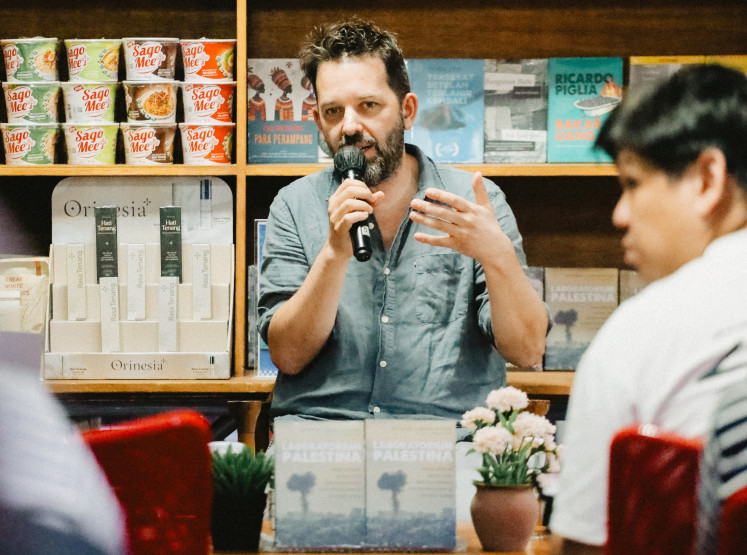Popular Reads
Top Results
Can't find what you're looking for?
View all search resultsPopular Reads
Top Results
Can't find what you're looking for?
View all search resultsYayoi Kusama: A history of art and mental illness
Kusama's pieces, like the works of many artists before her, are the product of a long struggle with mental illness.
Change text size
Gift Premium Articles
to Anyone
I
f you live in Indonesia, you've probably heard of Yayoi Kusama's recently opened exhibition in Jakarta's Museum MACAN. Even if you haven't heard of it, you've almost definitely seen it.
For the past few weeks, Instagram has been filled with pictures of people modeling in front of infinity dots, infinity nets, and/or infinity mirrors. Kusama's exhibits are admittedly eye-catching and aesthetically pleasing, so it's no surprise that both common museum-goers and Instagram celebrities have pounced on the opportunity for photo ops to up their Instagram game.
Insta-models aside, there's much more going on with the story behind the creation of the exhibits than a simple admiration of dots. Kusama's pieces, like the works of many artists before her, are the product of a long struggle with mental illness.
Read also: Common art exhibition rules and why you should obey them
Links between art and mental illness are found throughout history. Search the two terms together, and you'll find the names of many famous painters that struggled with mental illness, like Edvard Munch, Vincent Van Gogh and Pablo Picasso.
Often amiss in their biographies, these artists managed to create amazing masterpieces despite fighting invisible mental battles. However, the link between art and mental illness transcends paintings. Famous actors like Ryan Reynolds, James Franco and Emma Stone, as well as renowned musicians like Kendrick Lamar, Lady Gaga and Kesha, have all opened up about their struggles with depression, suicidal thoughts and other mental illnesses. Obviously, this does not mean all artists face mental illnesses, but the fact that many of them do face problems with their mental health is irrefutable.
So, what explains this link? It likely has something to do with the therapeutic effects ascribed to art, which gives creative minds an outlet to express their feelings freely. In a study published by the American Journal of Public Health in 2010, researchers found that artistic expression had many positive outcomes on the health and wellness of medically ill patients. Activities like drawing or writing were proven to have both physical and mental benefits for patients diagnosed with cancer, HIV and other chronic illnesses.
Art therapy has become a worldwide phenomenon, with international art therapy organizations like Art Therapy Without Borders (ATWB) pioneering the creation of art therapy initiatives all over the world. Millions of people also use art for therapy, not necessarily as a psychotherapy process of healing, but rather as a simple activity to calm them down or to gain a sense of peace.
Read also: How to support your mental health by keeping a journal
For artists living with mental illness, the canvas is a place to express repressed emotions and to comprehend what's going on inside their head. Edvard Munch faced mental breakdowns and is thought to have been plagued with other mental illnesses. Many of his paintings represent those struggles, often illustrating figures in pain or torment, most famously, perhaps, his painting The Scream. Jackson Pollock, the American artist known for his "drip paintings", went through multiple psychiatric treatments for bipolar disorder, painting many pieces of artwork as a part of his treatment. Vincent Van Gogh notoriously cut off his own ear after a psychotic outbreak, leading him to paint a self-portrait of himself with a bandaged ear.
In the case of Kusama, the artist herself has testified to the influence of her mental illness on her art. Raised in a loveless household and currently residing in a mental hospital, Kusama's art reflects her experiences, whether they be hallucinations, her obsession with dots or her struggle to understand sexuality. Her hallucinations became her Infinity Net series; her obsessions with dots, the Obliteration Room; her struggle with sexuality, the Accumulations series. These pieces have been celebrated worldwide, her sculptures and paintings highlighting exhibitions in almost every continent.
Sadly, many of the discussions are still directed to the aesthetic pleasure derived from the pieces, rather than the purpose behind their creation and their significance for Kusama's healing process.
Yayoi Kusama is also a trailblazer for Asian art. Despite its long history, the relationship between art and mental illness is poorly documented in Eastern art history. Eastern nations, like China, Japan, and even Indonesia, are much less open to mental illness, due to a lack of understanding and a habit of attributing symptoms of mental illness with supernatural possession or punishment from ancestral spirits.
Although there has been progress on how people understand mental illness, many Asian nations still see heavy stigmas put on those that have problems with their mental health. In that aspect, Kusama’s art is not only a tableau of her life experiences, but also a rebellion against Asian stigmas, proving that depression and mental illness are not necessarily obstacles to a productive life, nor do they hinder the creation of works that millions of other people can enjoy and, hopefully, relate to.
There's nothing wrong with taking pictures. Appreciation comes in many forms, and Kusama’s piece Narcissus Garden contemplates humans’ innate desire for narcissism, so she probably understands it if people only want to take pictures.
But next time you go to Kusama's exhibition, try to stop for a few seconds at each exhibit and read the descriptions of the paintings and sculptures. Maybe you’ll find more meaning behind the pieces.
Or maybe you’ll start to understand that she’s not only creating art for your Instagram feed – she’s trying to show you how her mental illness makes her see the world. (kes)
***
An avid film watcher, Haikal aspires to one day sit in a director’s chair. He reviews movies on his Instagram account @haikalstr for fun.











